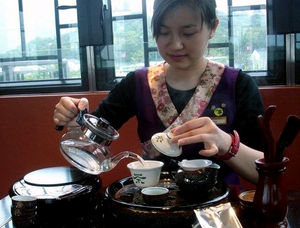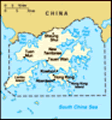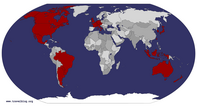Advertisement
Published: April 26th 2008

 Rejuvenating tea ceremony?
Rejuvenating tea ceremony?
Here is my tea specialist serving my evening tea. And did she say Lan Zi?!“So you’re Lan Zi,” my tea specialist concluded in her broken English. She was suspiciously staring at me as if I had just poured hot water all over her delicate hand. I just finished explaining my lame excuse for not being able to talk in any of the Chinese dialects fluently - the ability to speaking Chinese stopped in my generation because I was born in the non-Chinese-speaking country of Indonesia. That, and I now live in the United States.
“Lan Zi, what’s that?” I thought. I just innocently blinked at her, while sipping my precious Ti Kuan Yin Oolong Tea. We were in the middle of an ancient tea ceremony that WAS supposed to be a rejuvenation experience for me.
She shook her head, took a deep breath, and continued on with our interesting conversation - in English, of course.
It turned out that ‘Lan Zi’ is a term that refers to an individual who has traveled far away from home and has forgotten about his background - ancestors, family and culture. While this might be nonsense for people from western cultures, it is somewhat an intolerant act for eastern cultures - Chinese in particular. So who

 Man Mo Temple
Man Mo Temple
As if prayers are answered from the heaven.would be taking care of one’s parents in their older days? Who would bring honor to the family’s name? Who would carry on the proud, ancient Chinese culture, as it has existed for more than four thousand years? In her eyes, I was just an ignorant individual who was ashamed of my background. It was a serious accusation, and it made me think very hard. It depends on how you see it. It is true that it has been a while since I last stepped foot back in China. It’s been several centuries some my ancestors left China on a boat (I assume.) On the other hand, I am still proud to be Chinese by ethnicity. There is no question about that. But a Lan Zi?
Landing in the Special Administrative Region of Hong Kong, I was reminded that this is now part of the Motherland of Zhung Quo (China Mainland). Chinese people are always proud of who they are and where they come from, and anywhere in the world you will always find the Chinese and their descendants still practicing China’s traditions, customs, culture, and languages.
The big bang of Hong Kong’s recent history was its handover

 Joss sticks detail
Joss sticks detail
Po Lin Monastery, Lantau Island.back to the China Mainland in 1997 after had been a British Colony for hundreds of years. As some of the terrified residents fled abroad from Hong Kong (many of whom now reside in Vancouver, Canada), the rest stayed and embraced the reunification of the two countries.
Hong Kong is one of the most densely populated cities in the world; as a result, the price of its land is ridiculously expensive, and due to a lack of available space, Hong Kong is in constant change from rebuilding. From what I’ve read, the government unfortunately doesn’t pay much attention to preserving some of the city’s historical landmarks, and as soon as the wrecking balls finish engulfing the old unwanted structures, the construction of new sites start immediately, building the modern typical glass and steel high-rise structure.
Northern Hong Kong Island and the adjacent southern Kowloon Peninsula look like modern Gotham city, with skyscrapers jutted up high along the picturesque Victoria Harbour, creating an exciting haven for any architecture enthusiast. Famous world class architects such as Chinese American I.M. Pei and British Sir Norman Foster have contributed their designs to the Hong Kong skyline, and Hong Kong is honored to

 Hong Kong
Hong Kong
This is the hard way to write 'Hong Kong'.be the city with the most skyscrapers in the world - surpassing the second place New York City by about two thousand structures.
One of the most eye-catching structures on the Island is the Bank of China tower (completed in 1990), which has a unique geometric shape and distinctive stripes across its surface. The controversial tower has many elements that would make Feng Shui experts stroke some disapproving marks in their scrolls and subsequently faint (despite the fact that high-profile architect I.M. Pei has said otherwise.) It is said that the tower’s sharp angles cast negative Feng Shui toward the heart of Hong Kong. Regardless of what they say, I enjoyed my experience looking down from the Bank of China’s 43rd level Observation Deck, where one can look far beyond Victoria Harbour to Kowloon Peninsula, where more skylines were built to match its rival in Hong Kong Island. Unfortunately, it was a cloudy day in Hong Kong, so the view was somewhat limited.
Hong Kong Island is an amazing place to experience. One of the best places to appreciate its majestic skylines is from atop Victoria Peak, which is accessible by riding the double reversible funicular railway ‘The

 Tian Tan
Tian Tan
The biggest outdoor, bronze sitting Buddha statue in the world.Peak Tram’. Inaugurated in 1888, it was intended to transport locals up and down the urban hill. Nowadays, it serves more to cater to Hong Kong tourism. The seven-minute ride is a hike up a 27-degree angle, making it one of the steepest railways in the world. On my ride uphill, I had an interesting discussion with a burly Canadian guy who was just getting back from Mt. Everest about North American clothing (he was wearing a pairs of shorts and soccer sandals - a big sore thumb for most of the world).
Another way to view the majestic Hong Kong skyline is by riding the iconic Star Ferry across Victoria Harbour to Tsim Tsha Tsui in Kowloon. It was a nice afternoon when our green ferry glided across the open water, and all of the tall buildings were revealed right before our eyes.
China is excited to host the Beijing 2008 Summer Olympics - everywhere you go in the country (well, at least in Hong Kong), there are events and colorful decorations to celebrate the Olympics spirit. Hong Kong is directly affected by “Beijing 2008” in two ways: one, by having the Olympic Torch route pass through

 Bus Stop
Bus Stop
There must be an easier way to write a 'Bus Stop' on the road than this.the region on May 2nd, and two, by becoming the co-host of the equestrian events during the Olympics itself.
I have been closely watching current events about how the Beijing 2008 Olympic Torch Relay is becoming an on-going protest event around the world for Free Tibet movement - in London, Paris, and San Francisco (to name a few.) People are nervous about how Hong Kong citizen will react to the Olympic Torch Relay event.
There is still tranquility to be found in Hong Kong, like on Lantau Island, home of the Tian Tan giant Buddha structure. In the middle of gently rolling hills of ‘natural’ forest and hiking trails, Lord Gautama is meditating on top of his elevated Nirvana. Claim to be the biggest outdoor, bronze-sitting Buddha Statue in the world (there are other bigger Buddha statues somewhere else, but apparently they are not outdoor, bronze, or sitting at the same time), Tian Tan has become a landmark for Hong Kong. It is 24.4 meters tall (80 feet) - roughly the equivalent of a nine story building. Getting there is a challenge. The picturesque way to do so is by floating the 7 kilometers (4.5 miles) in the

 Ngong Ping cable car
Ngong Ping cable car
This is the best way to go to the Tian Tan Big Buddha on Lantau Island.Ngong Ping cable car.
The Tian Tan Big Buddha is located next to the modest Po Lin Buddhist monastery. It is one of the most significant religious sites in Asia due to its important role of hosting one of the Buddha’s holy white bone relics received from Sri Lanka. There is a small museum inside the Tian Tan where I saw the Holy Relic and learned all about three types of Buddha relics: white, black and red representing bone, hair and the flesh of Buddha, respectably. The museum admission ticket included a vegetarian meal at the Monastery Dining Hall. The meal was very delicious, and one of the best I’ve had for a while.
And, of course, I cannot forget to mention the Ngong Ping Village on Tian Tan’s foot, where I decided to have my fateful evening tea break. What I had originally thought was to be a quick, simple sip of authentic Chinese tea, turned out to be an ancient tea ceremony, with several rituals such as cup washing, tea soaking, water warming and tea sipping. It is actually a rejuvenating practice; I had more energy to keep me going after having the medicinal tea. No

 Tian Tan
Tian Tan
Lord Gautama is sitting in traquility.wonder Chinese people always had tea as an enjoyment, instead of how we abuse tea by drinking it sweet in our lovely western culture.
Looks can be deceiving, as I finally concluded. When locals ask me where I come from, nobody accepts the answer of ‘Indonesia’ or the ‘U.S.A.’ They feel like they need to dig deeper until I reply with ‘My grandparents are from Fu Jien’ (a region in southern China.) They would nod approvingly. Then their eyes would open wide and the conversation would continue to the ‘lan zi’ topic once again.
Sigh.
Advertisement
Tot: 0.051s; Tpl: 0.016s; cc: 9; qc: 23; dbt: 0.0249s; 1; m:domysql w:travelblog (10.17.0.13); sld: 1;
; mem: 1.1mb

























Steven
non-member comment
while you are in china
http://ngm.nationalgeographic.com/2008/05/china/guizhou/amy-tan-text